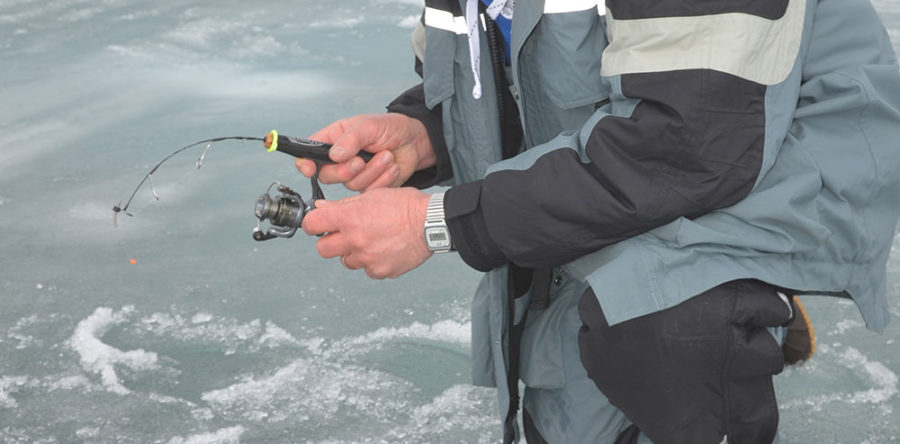by: Terry Tuma
As the first ice of winter 2017-18 becomes legitimately fishable, here are some of the top questions I’ve answered at recent seminars at destinations such as the St. Paul Ice Fishing and Winter Sports Show and at Cabela’s. Good luck to everyone as ice angling gets going, and please remember: safety first!
Q: What is the primary food source of crappies and sunfish in winter?
“Tackle” Terry Tuma: Zooplankton make up their main winter meals. But I break it down into two categories: daphnia and copepods. If we understand how these creatures move, we’ll enhance our success. For instance, daphnia rise under low light conditions. As morning progresses, they’ll descend in the water column, thus becoming tougher for fish to approach.
Food sources will shift during the day to copepods, which are active in bright conditions. Weather, snow cover, ice thickness, and water clarity all affect zooplankton activity. This is why changes in jigging actions, bait sizes, water column depths, and locations are crucial in enjoying a great day on the ice.
Q: How can I remove line coils on ice fishing spinning reels?
T3: For starters, replace line every ice-fishing season, then spool on new line throughout the winter for above-average use. Line should spool on tight and in the correct direction coming off the line spool and onto the reel. Use line recommended for ice angling.
Always avoid reeling in fish with a slipping drag. Periodically raise line out of the hole and let it spin. Final step is to stretch line by attaching the tag end to a solid object and back away several yards. We must eliminate coils to feel and understand how line is behaving.
Q: An ice-angling buddy says I should add three minnow heads – one on each treble hook tine – to vertical jigging spoons. Your impressions?
T3: Hook one head on the tine through the lips for flash and scent. That will suffice. Try pinching the head off either behind the dorsal fin or just behind the gill plate to offer a larger or smaller profile. Hook a whole minnow on one tine along the dorsal fin for aggressive walleyes. Catching fish is a process of elimination with no set standard. Read the conditions, then react. Expect conditions to change … then react again!
Q: How do you attract and entice bites from fish when ice angling?
T3: Begin with aggressive rod movement, which draws fish into your cone angle. Experiment with jigging to see which technique is most productive. Once fish appear on the screen, start raising the lure up a few inches at a time to tempt them up. This will vary from inches to approximately 2 feet. Hold your lure steady if they refuse to rise. If they don’t hammer it, twitch the lure. If the fish refuses to bite, target another one. Don’t waste time. Jig in, then jig up, and hold.
Q: On radio recently, you commented on finicky winter walleyes that “bite up.” Please elaborate on this puzzling phenomenon.
T3: When fish are just bumping or mouthing a jig-and-minnowhead combo, try this tactic: Raise the bait 1 to 2 inches above the band (fish display) on your electronics to tease the walleye up in the water column. Often this will trigger a strike. Continue to lift a couple more inches to coax a bite if the first lift doesn’t produce. Then tickle the rod blank to provide subtle bait movement. Don’t waste any more time if you can’t connect. Lower the jig and try for another walleye. This tactic requires patience and concentration.
Q: What lures do you use for ice fishing walleyes?
T3: Generally speaking, I begin with swimming lures for aggressive and even some neutral walleyes. If this doesn’t produce, then I’ll drop vertical jigging spoons down the hole starting with flash vibrations then switch to strictly flash. The third style is slow-falling, flutter action spoons. Progressing down the ladder, switch to jigs tipped with minnows or minnow heads for non-aggressive fish. A final, excellent choice is deadsticking. This works for second-hole options, too, with colored hooks, beads, and various minnow sizes and species. For success, always address color, jigging action, weather, and fishing pressure in your complete ice formula.
Q: Most people fish winter crappies via bobber, hook, and minnow. I’m thinking of trying spring bobbers. Ever used this tool?
T3: Without question! Spring bobbers with minnows offer big advantages. One is depth adjustment. We can present bait in the immediate strike zone by watching our electronics for fish and bait locations in the water column. This saves time by eliminating manual settings of bobbers or stops. Fish depth will vary daily and hourly. Use a split shot only heavy enough to bend the spring just below the rod tip – not at a 90-degree angle. Consider stiff springs or ones with ample tension. This method is faster plus it’s a visual aid for light biters and monitoring minnow movement.






